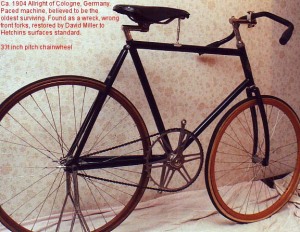The following post is in German, for once, because it outlines a presentation I gave at the Feb 25 Bielefeld/Germany conference on old bicycles held by the German cycle collectors´ club. The purpose of the presentation was to familiarize German collectors with the basics of Sturmey club and racing hub production. In Germany little is known about this, and I also hoped to rectify the local prejudice that Sturmey hubs are badly made and unreliable.
A list of the literature used is given below; all illustrations in this post are commented on and used for scientific purposes. It is not OK to copy them out of this blog.

In den dreißiger und vierziger Jahren war es in Großbritannien durchaus noch nicht sicher, ob nicht Nabenschaltungen eine gute Chance haben würden, sich neben Kettenschaltungen am Markt zu halten, oder diese sogar auf die Plätze zu verweisen. Klassische Kettenschaltungen waren zum Beispiel die Cyclo, von der bis Ende 1929 nach Berto, Dancing Chain 3rd ed, gerade mal 150 Stück verkauft worden waren. In der britischen Radfahrpresse war zu jener Zeit die perfekte Kettenlinie das Maß allen Erfolgs beim Antrieb des Fahrrads, und die ist nun einmal mit einer Kettenschaltung nicht zu haben.
Auch sorgte das typisch britische Zeitfahren dafür, dass auf meist flachen Rundkursen, auf denen möglichst gleichbleibende Geschwindigkeiten gefahren werden sollten, Kettenschaltungen nicht nötig waren. Darüberhinaus waren Massenstart-Rennen, ab Anfang der Vierziger organisiert von der BLRC, lange Zeit nicht offiziell erlaubt (Messenger, Ride and be Damned) und eine Teilnahme führte zu Sperren bei den erheblich weiter verbreiteten Zeitfahren der NCU.
Besonders Sturmey-Archer brannte ein wahres Feuerwerk an Naben ab, die mit Renn- oder Sportabstufungen angeboten wurden und zum Teil technisch sehr anspruchsvoll waren. Einige hatten beispielsweise doppelte Planetensysteme.

In der Weihnachts-Ausgabe 1936 von Cycling fand sich diese Anzeige, in der vier Sportnaben angepriesen werden, die TC, TF, KS und KSW.
Ab 1938 ersetzte die A-Reihe die K. Die TF überstand als Zweigang den Modellwechsel und wurde bis 1940 gebaut.

Die T/TF war ein recht leichtgewichtiger Ersatz für die damals noch populären, aber umständlichen Wendenaben: Wollte man bei ihnen einen Gang wechseln, musste das Hinterrad ausgebaut, umgedreht und wieder eingebaut werden, weil sich je ein Ritzel auf den beiden Seiten der Nabe befand. Da war selbst eine Zweigangnabe wie die T schon eine deutliche Erleichterung. Im Gegensatz zum Doppeltorpedo war die T nicht mit Rücktritt erhältlich, was dem sportlichen Einsatz der T geschuldet war.

Es half der Kettenschaltung nicht gerade, dass Raleigh, die größte Fahrradfabrik der Welt mit fast hundertprozentiger Fertigungstiefe, bis mindestens 1948 ausschließlich Nabenschaltungen von Sturmey, das Raleigh gehörte, verbaute.

Weiterhin wurde Sturmey natürlich nicht müde, Rennerfolge und Rekordfahrten, bei denen seine Schaltnaben verwendet wurden, in der Werbung herauszustreichen. Tommy Godwin, der vom 1.1. bis 31.12. 1939 einen neuen Rekord von 75.065 zurückgelegten Meilen aufstellte, fuhr ebenfalls eine Sturmey-Schaltung, die AF-Viergang-Sportnabe.

Die CTC Silver Plaque, eine in den 20er und 30er Jahren vom größten Fahrradclub der Welt vergebene Auszeichnung für die herausragendste Fahrrad-Innovation des Jahres, wurde 1939 an eben diese AF-Nabe vergeben, und nicht etwa an eine Kettenschaltung.

Selbst nach dem Zweiten Weltkrieg noch schuf Sturmey wahre Ikonen der Sportnaben-Welt wie die ASC, eine starre Dreigangnabe mit mittlerer Abstufung, die heutzutage bei Sammlern Höchstpreise erzielt und die 2010 von SunRace-Sturmey-Archer unter dem Namen S3X wiederaufgelegt wurde. Die Innereien sind allerdings – wie die Übersetzung – verändert und entstammen teils der neuen Fünfgangnabe, die Funktion der freilauflosen Dreigangnabe allerdings ist identisch.

Und dies ist der Mann, dem wir fast alle der wunderbaren Sturmey-Drei- und Viergänge zu verdanken haben. Seinen Hut nehmen musste er nach der Pleite mit der SW-Nabe Mitte der Fünfziger. Er konstruierte praktisch alle Schaltungsnaben in der Anzeige unten, die aus der Mitte der Fünfziger, vor der Einführung der SW im Jahr 1956, stammt.

Zum Schluss noch zwei Tabellen, die ich großteils nach Hadland zusammengestellt habe. Draufklicken zum Vergrößern.
Korrektur: Bei der Datierung der Dreißiger-Jahre-Naben ist nach der Typenkennung kein Jahres-Buchstabe, sondern eine Jahreszahl verwendet worden.
































































































